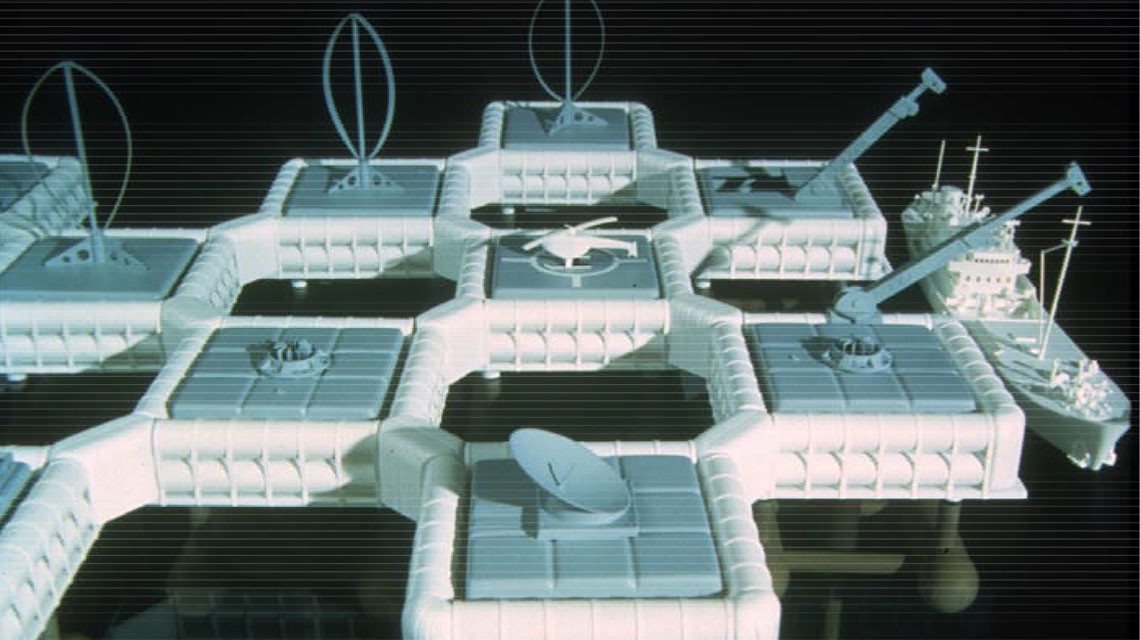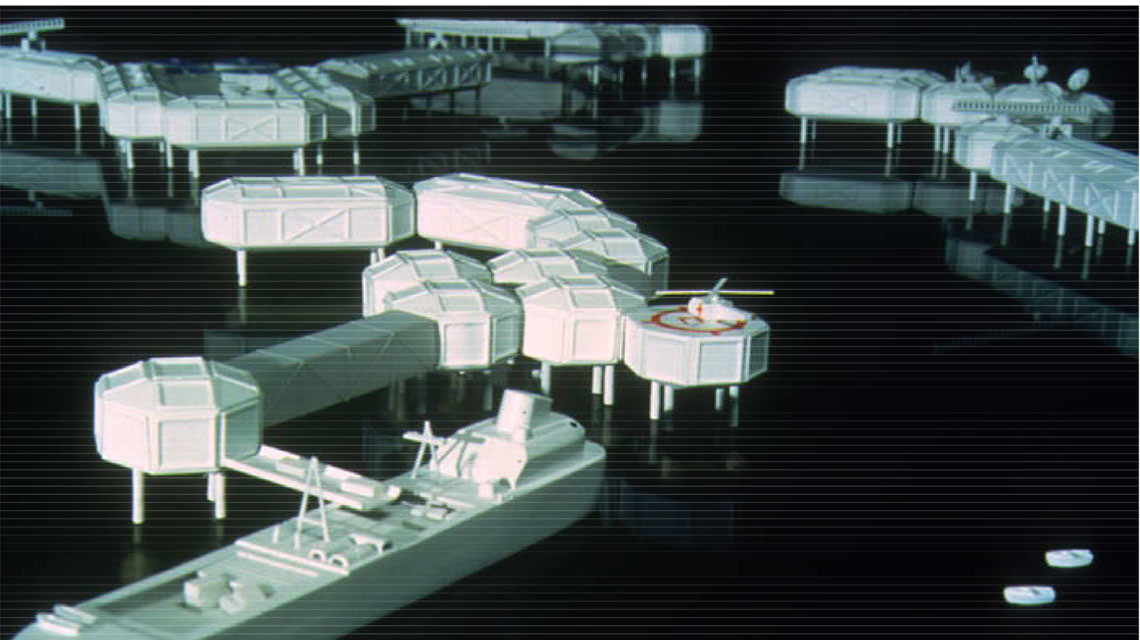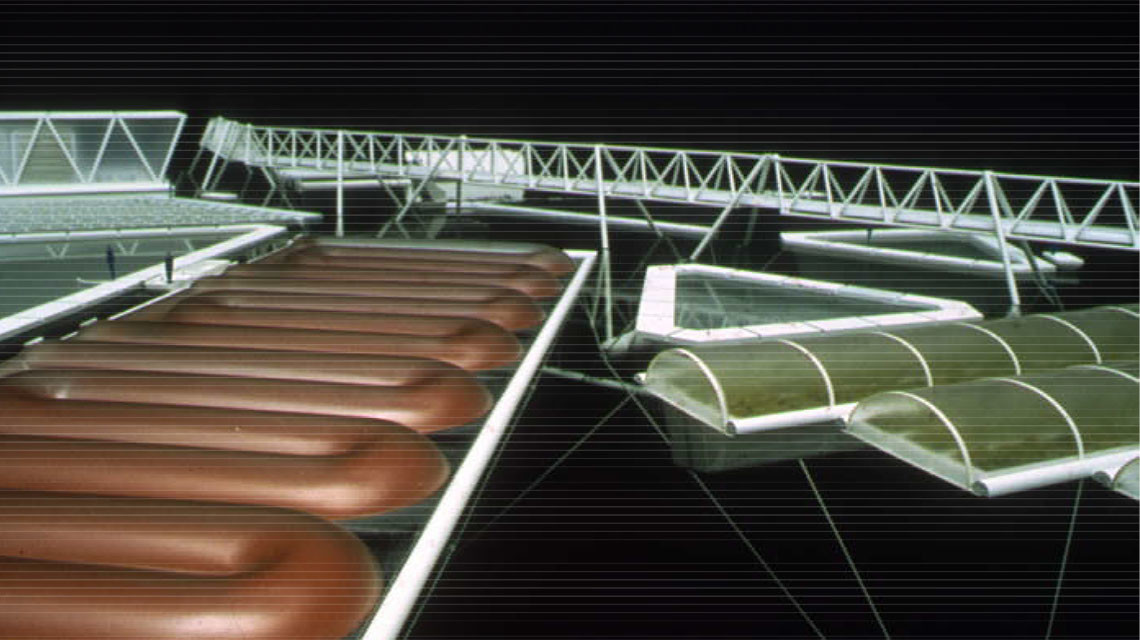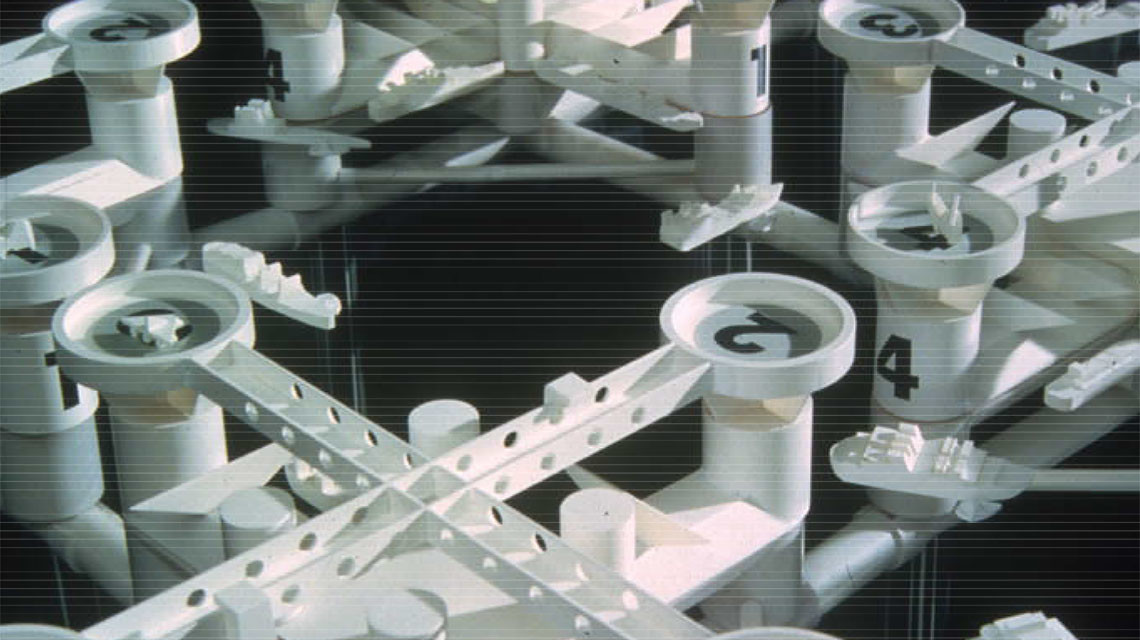
Synopsis
Mankind is inextricably bound to the water. Beyond our own obvious physiological needs, there are its associations with other life forms of concern to us, its importance as a medium for transportation and commerce, and above all its very omnipresence. Three quarters of the Earth’s surface is covered by water, and a great percentage of the world’s population lives close to large bodies of water.
The contrast between development of the resources of land and sea, however, is sharp. The disparity suggests that, as we near the new millennium, we consider thoughtfully how to extend to the seas the understanding we have gained in developing the land for human habitation and support of our societies. Activities that were conceived for and evolved on land might now be better conducted on the waters, given the maturation of our technological knowledge and the crowding of our land base.
“Aquatecture” is a conceptual systems design project. Drawing on the computer-supported techniques of Structured Planning, it explores possibilities for uses of water resources for food production, transportation, energy development and manufacturing. Four individual subprojects deal with these subjects as “Floating Fields”, “CrossRoads in the Sea”, “Patterned Energy” and “Mobile Offshore Industry”. Each of the four projects speculates on how a “macrodesigned” environment might be developed using known technology to expand the uses of the seas, lakes and rivers as space, media and sources of energy, food and raw materials.
The projects were done in the Systems and Systematic Design course at the Institute of Design. This course is the final course in a three-course sequence for product design students beginning with Product Design, continuing with Environmental Design, and ending with the Systems and Systematic Design course. The Systems course deals with products working in concert to achieve goals; the development of comprehensive design concepts; the problems of teamwork in design; and the use of systematic, computer-supported design techniques (Structured Planning) for handling complex problems.
The topic for the fall, 1986 course was the Japan Design Foundation’s Third International Design Competition. Within the competition theme of “water”, four study areas were set out: food production, transportation, energy and materials processing. Research in these areas evolved projects, collectively entitled “Aquatecture”, which envision large-scale structures for use in the oceans, lakes and rivers to extend man’s abilities to work in the water environment.
The four projects were completed in four months and submitted to the competition in January, 1987. From a field of 2,281 entries representing 58 countries, 1,144 projects were actually submitted from professionals and students in 48 countries. All four of the Institute of Design projects survived the first round to be among 59 finalists. After another month of work to prepare final presentations, a second submission was made in June. Final competition results were announced in August: the four Aquatecture projects were together awarded the Grand Prize of 10,000,000 yen ($78,500). The award, made in Osaka on October 30, 1987, marked the second time in three competitions that Institute of Design students had won the Grand Prize.
Final Results
Aquatecture: Floating Fields
The water environments of the world provide ideal locations for the production of food. Aquaculture and mariculture successes already prove the potential for farming the seas, lakes and rivers. What remains is to design structural systems capable of incorporating the variety of processes possible into integrated production facilities tailored to the water environment, its nutritive qualities and the crop requirements of the farmers.
“Floating Fields” establishes farming in a new frontier. Land farming (in the form of hydroponics) as well as water farming is moved from increasingly crowded and valuable land locations to new sites on the water. Within an “aquatecture” structure, a floating Distribution Spine anchored to the bottom connects a number of kinds of production facilities. The Distribution Spine organizes the system and provides a path for moving materials, seedlings and harvests between fields and processing facilities.
Proposal PDF: Aquatecture_floating_fields
Aquatecture: CrossRoads in the Sea
Transportation in a world of growing population and denser population centers faces dilemmas of space and location. Trends are to larger and larger “regional” interchanges for intermodal transportation, but these, because of their size and activity, must increasingly be located at inconvenient distances from the urban centers they serve. “CrossRoads in the Sea” examines the potential for floating “aquatectural” structures of great size to take advantage of the nearness of the great majority of large urban centers to large bodies of water.
In a CrossRoads installation, aquatectural Interchange structures approximately 400 meters square rise 80 meters above the water surface. Elements of the structures above the surface serve shipping and air traffic. Below the water level, tubes 20 meters in diameter connect units of the system and, where feasible, connect the system to land with multiple lanes of rail and/or automotive traffic. All structures (including the transport tubes to land) are buoyant and are held below the surface with cables tensioned dynamically to adjust to tidal and weather conditions.
Proposal PDF: Aquatecture_crossroads in the sea
Aquatecture: Patterned Energy
As the world’s resources of fossil fuels dwindle, the value of alternative natural energy sources grows. Natural sources, however, are not particularly reliable in the consistency of their output — all days are not sunny, and the wind does not always blow. Combinations of power sources are an effective answer, and a water environment for major energy systems is a location of choice for several reasons: (1) wave action and temperature differentials in large bodies of water add additional sources of energy; (2) water pathways connect the great majority of urban settlements, making the transportation and relocation of large energy systems a realistic possibility; and (3) a large percentage of major cities are on or near large bodies of water — land near them is both scarce and expensive, while water locations offer advantages of performance, cost, safety and security.
Proposal PDF: Aquatecture_patterned energy
Aquatecture: Mobile Offshore Industry
A strong case can be made for moving industry onto the water. Because of the need for massive quantities of raw materials and the requirement for distributing large finished products, much of heavy industry already is located as near as possible to waterways. In a world economy, raw materials and products are frequently seaborne during some portion of their transit. “Mobile Offshore Industry” reduces discontinuities. Factories on the sea can travel to sites where labor and materials are in favorable supply, or where products must be supplied to just-in-time schedules. Materials processing can be conducted where the materials are: off remote shores, over seabottoms, near fishing fleets or with other aquatectural structures. Demonstration factories can bring manufacturing to developing urban centers. Plant configurations can almost exactly follow flowcharts — a practical metaphor virtually unobtainable in crowded urban environments.


